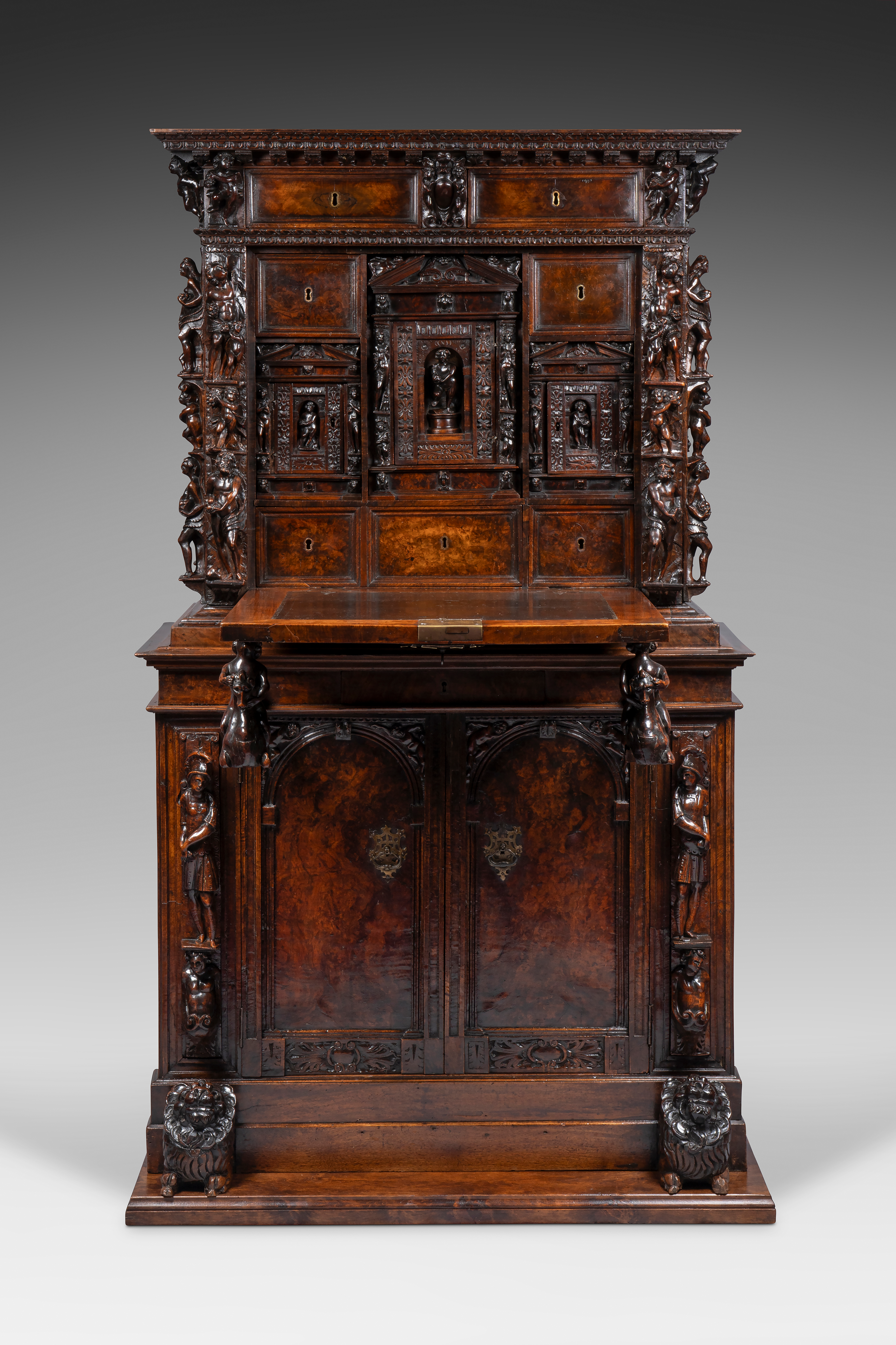Description
HISTORICAL CONTEXT
This Stipo, Italian cabinet made of walnut and walnut burl, is a remarkable example of Mannerism applied to decorative arts during the late 16th century.
While the Mannerist movement was born and developed in Florence before becoming international, it is in Northern Italy that Mannerism fully bloomed during the late 16th and early 17th century.
Contrary to the rest of Italy where classical motifs are adopted very early on, Renaissance decorative elements persist very late all through the 17th century in the Northern regions.
It is in Liguria that this fashion appears the most clearly on furniture and especially in Genoa where appears a whole category of cabinets with richly carved decor of exuberant figures called bambocci. This specifically Genoan type of furniture draws inspiration from Tuscan Mannerism.
DESCRIPTION
Rarely have rigor and fantasy reached such a level of perfection and balance. This Stipo, an Italian cabinet, is above all a piece of furniture dedicated to secrecy, with its main theme being: Abundance.
Highly architectural, the Stipo consists of a lower section with two doors simulating arched gateways, adorned with putti in the spandrels, upon which the cabinet rests, closed by a thick drop-front that seals it like a fortress. The beautiful smooth surface of walnut burl highlights the gilded metal keyholes and lock plates, intricately crafted with deeply cut foliate designs. In contrast, it emphasizes the strength of the framing, featuring small figurines masterfully sculpted in high relief from a single block of walnut, then applied to each upright. Inspired by ‘bambocci’, these figures are far more elaborate, individualized, and richly symbolic. They form a hymn to life and the deities of nature – creatures of the woods and waters bearing offerings, symbols of abundance. Highlighted prominently, they are supported by putti acting as Atlantes.
On the lower section, centurions evoke Roman mythology. They are supported as consoles by caryatids nestled within scrolls. The same theme is carried through the upper section.
The sculptures are the work of a skilled atelier. Each figure is a masterpiece of harmony and grace, with anatomical detail and a striking precision in the facial features and hairstyles. On each side, elderly figures support a winged cherub acting as an Atlas, holding up a young woman dressed in a simple veil, accompanied by her putto, with arms full of offerings.
The sides of the cabinet also feature isolated figures of men and women in Roman fashion, always shown offering gifts.
On the entablature, two winged putti frame two drawers, separated by a central coat of arms resting on a curled leather scroll held by two cherubs. These figures support the overhanging cornice, adorned with console modillions, egg-and-dart friezes, and palmettes.
When opened, the drop-front becomes a writing table, a reminder that the Stipo was originally a secretary desk. To ensure stability, two pull-out supports housed in the entablature of the lower section hold it in place. Both decorative and functional, the supports are adorned with a sculpted putto riding a sea horse in high relief.
The feet of the Stipo feature two beautifully crafted lion heads with generously curled manes.
When the drop-front is opened, an architectural design reminiscent of an Italian palace is revealed. In the lower register, two drawers appear as three for the sake of symmetry. In the middle register, three lockable doors open to reveal a compartment of stacked drawers, each with its own discreet, hidden sub-drawer, which, although adorned with cherub heads, remains concealed. Not to mention the multiple secret compartments waiting to be discovered.
Each door, resembling a miniature portico, is flanked by figurines on the uprights, with a cherub nestled in a central niche framed by stylized leaves. Above this, an entablature and a broken pediment adorned with scrolls and cherubs in the spandrels complete the design. Behind the false fronts, further secrets are concealed.
At the top, two drawers are positioned in the corners, all crafted in walnut burl.
This richly decorated Stipo, having preserved its original base, was undoubtedly the centerpiece of a grand hall in a palace in Genoa, Milan, or Florence. It can be compared to the Stipo from the collection of Baron Pasino Bagatti Valsecchi di Belvignate in Milan.

Bibliography :
L’Arte del mobile in Italia par Silvanno Colombo.
Il Mobiglio, gli ambianti e le Decorazioni del Rinascimiento in Italia par Augusto Pedrini
Il Mobilio in Italia par Augusto Pedrini, 1948.




